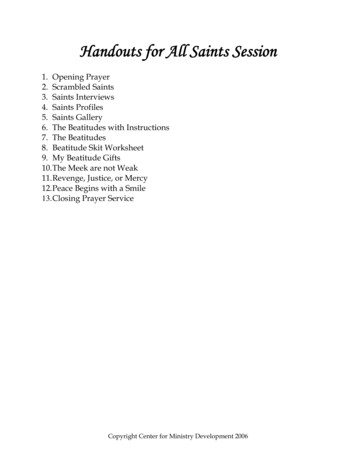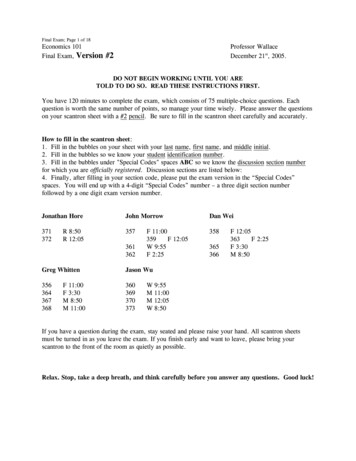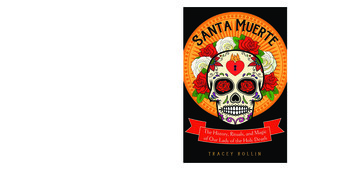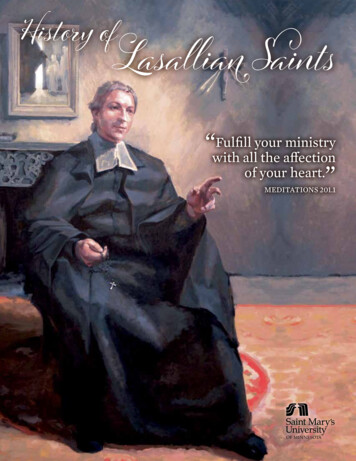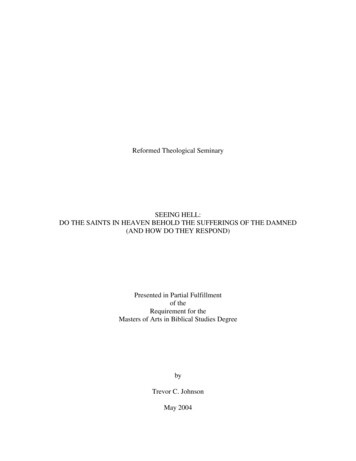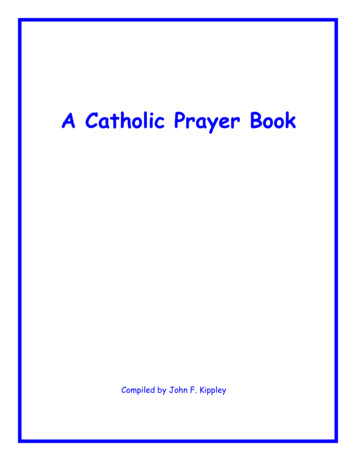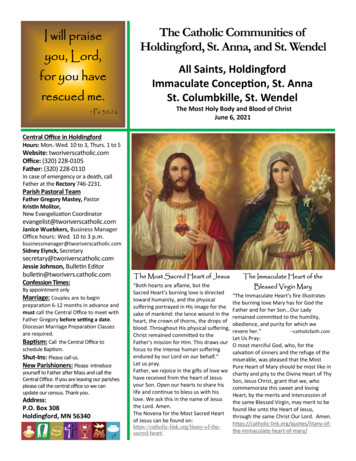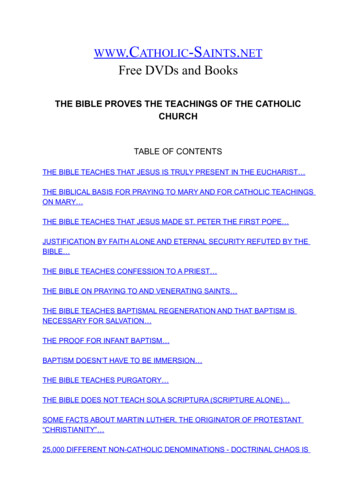
Transcription
WWW.CATHOLIC-SAINTS.NETFree DVDs and BooksTHE BIBLE PROVES THE TEACHINGS OF THE CATHOLICCHURCHTABLE OF CONTENTSTHE BIBLE TEACHES THAT JESUS IS TRULY PRESENT IN THE EUCHARIST THE BIBLICAL BASIS FOR PRAYING TO MARY AND FOR CATHOLIC TEACHINGSON MARY THE BIBLE TEACHES THAT JESUS MADE ST. PETER THE FIRST POPE JUSTIFICATION BY FAITH ALONE AND ETERNAL SECURITY REFUTED BY THEBIBLE THE BIBLE TEACHES CONFESSION TO A PRIEST THE BIBLE ON PRAYING TO AND VENERATING SAINTS THE BIBLE TEACHES BAPTISMAL REGENERATION AND THAT BAPTISM ISNECESSARY FOR SALVATION THE PROOF FOR INFANT BAPTISM BAPTISM DOESN’T HAVE TO BE IMMERSION THE BIBLE TEACHES PURGATORY THE BIBLE DOES NOT TEACH SOLA SCRIPTURA (SCRIPTURE ALONE) SOME FACTS ABOUT MARTIN LUTHER, THE ORIGINATOR OF PROTESTANT“CHRISTIANITY” 25,000 DIFFERENT NON-CATHOLIC DENOMINATIONS - DOCTRINAL CHAOS IS
THE BAD FRUIT OF MAN-MADE RELIGION HOW OLD IS YOUR CHURCH?.
THE BIBLE TEACHES THAT JESUS IS TRULY PRESENT IN THE EUCHARISTJohn 6:53 “Then Jesus said unto them, Verily, verily, I say unto you, Except ye eat the flesh ofthe Son of man, and drink his blood, ye have no life in you.”Protestants do not believe that the Eucharist is the actual body, blood, soul and divinity ofJesus Christ. Catholics believe that after the consecration at Mass, “the Lord Jesus Christ, trueGod and true man, is truly, really, and substantially contained” in the Eucharist under theappearance of bread and wine (Council of Trent, Decree on the Eucharist). The Catholic viewof the Eucharist was unanimously held for the first 1,500 years of Christianity. The biblicalsupport for the Catholic teaching on the Eucharist is overwhelming and undeniable.IN JOHN CHAPTER 6, JESUS CLEARLY SAYS THAT HIS FLESH IS FOOD AND HISBLOOD IS DRINK, AND THAT YOU MUST EAT HIS FLESH AND DRINK HIS BLOODJohn 6:51-58 “I am the living bread which came down from heaven: if any man eat ofthis bread, he shall live forever: and the bread that I will give is my flesh, which I willgive for the life of the world. The Jews therefore strove among themselves, saying, Howcan this man give us his flesh to eat? Then Jesus said unto them, Verily, verily, I sayunto you, except ye eat the flesh of the Son of man, and drink his blood, ye have no lifein you. Whosoever eateth my flesh, and drinketh my blood, hath eternal life; and Iwill raise him up at the last day. For my flesh is meat indeed, and my blood is drinkindeed. He that eateth my flesh, and drinketh my blood, dwelleth in me, and I inhim. As the living Father hath sent me, and I live by the Father: so he that eateth me,even he shall live by me. This is that bread which came down from heaven: not as yourfathers did eat manna, and are dead: he that eateth of this bread shall live for ever.”Jesus says over and over again, in the clearest terms, that His flesh is food and His blood isdrink. He says that unless you eat His flesh and drink His blood you shall not have life in you.THE JEWS SCOFFED AT THE NOTION OF EATING HIS FLESH; IN RESPONSE, JESUSCONFIRMS THAT THIS IS EXACTLY WHAT HE MEANTNon-Catholics claim that the words of Jesus in John 6 are not meant to be understood literally.They claim that Jesus was speaking only metaphorically or symbolically. Such aninterpretation is not justified by the context of John 6. Furthermore, it is clearly refuted bywhat Jesus said to the Jews immediately after expressed their disbelief at the idea of eatingHis flesh.John 6:52-53 “The Jews therefore strove among themselves, saying, How can this mangive us his flesh to eat? Then Jesus said unto them, Verily, verily, I say unto you,Except ye eat the flesh of the Son of man, and drink his blood, ye have no life in
you.”The Jews did not believe that it was possible (or that Jesus could really mean) that He wouldgive them His flesh to eat. They said exactly what the Protestants are saying today. If Jesushad been speaking in purely metaphorical (rather than literal) terms, as the Protestants say,then here was the perfect opportunity for Him to assure them that their fears were unfounded.It was the perfect moment for Jesus to explain that He didn’t really mean that people wouldeat His flesh, but that He meant something else.So what does Jesus say to them? In response to their disbelief, we see that Jesus repeats thesame message, that it’s necessary to actually eat His flesh and drink His blood, but in evenstronger terms. He tells them that if they don’t eat His flesh and drink His blood they will nothave life in them (John 6:53).THERE’S MORE: IN JOHN 6:54, THE BIBLE SWITCHES FROM THE WORD PHAGO(MEANING “EAT”) TO TROGO (MEANING “CHEW” OR “GNAW”) TO LEAVE NODOUBT THAT JESUS ACTUALLY MEANS EATING HIS FLESHThe word phago (meaning “to eat” or “consume”) is used nine times in the original Greek textof John 6:23-53. Phago is sufficient to convey the idea of eating Jesus’ flesh. Immediatelyafter the Jews expressed their disbelief that Jesus could mean such a thing, we read (in John6:54) that Jesus switched to an even stronger and more graphic word. The word He thenused (in John 6:54 and following) is trogo. This word literally means “to gnaw, chew orcrunch,” as even a Protestant study bible accessible on the internet will confirm.1 Therefore,to eradicate all doubt about the necessity to eat His flesh, Jesus switches to a word whichmeans nothing but literal eating (“gnawing, chewing”). The same word trogo is used to meanliteral eating in Matthew 24:38 and John 13:18.John 6:54-56 “Whosoever eateth [trogo] my flesh, and drinketh my blood, hath eternallife; and I will raise him up at the last day. For my flesh is meat indeed, and my blood isdrink indeed. He that eateth [trogo] my flesh, and drinketh my blood, dwelleth in me,and I in him.”In light of this evidence, it is absurd to argue that Jesus didn’t mean that people wouldactually eat His flesh and drink His blood.WHAT ABOUT JOHN 6:63?Faced with the overwhelming evidence in John 6 that the Eucharist is the actual body andblood of Jesus, certain non-Catholics will look for anything to combat it. They will point toJohn umber 5176
John 6:63 “It is the spirit that quickeneth; the flesh profiteth nothing: the words that Ispeak unto you, they are spirit, and they are life.”They claim this indicates that Jesus didn’t really mean that people will eat His flesh. Thisclaim does not hold up, however. It is refuted by the following points.First, we know that Jesus is not talking about His flesh in the part of the verse where He says“the flesh profits nothing.” Consider this question: is the flesh of Jesus of no profit? Whatabout His Incarnation? How could He speak of His own flesh as profiting nothing, when Hejust said over and over (John 6:51, etc.) that His flesh is the life of the world?If Jesus was speaking of His flesh when He said that the flesh profits nothing, then He wascontradicting Himself. Jesus would have been saying that His flesh is the life of the world(John 6:51, etc.) just before telling them that “it profits nothing.”That’s impossible and ridiculous. Jesus was not speaking of His flesh when He said “the fleshprofits nothing.”Second, Jesus says that people need to eat His flesh and drink His blood (and that His flesh isfood) approximately ten times in this chapter. Not once does He indicate that His meaning isnot literal; nor does He do so here.Rather, by emphasizing to them that what He said about His flesh and blood is “spirit andlife,” Jesus was dispelling their notion that all they should be concerned with is having fleshto eat for the sustenance of physical life. The Eucharist is the actual flesh and blood ofJesus (as He makes clear), as well as His soul and divinity, but it primarily brings aspiritual endowment. It is spirit and life. It is primarily for the sustenance of spiritual life andhaving eternal life.It is not received for the purpose of filling a hungry stomach, but for the inestimable spirituallife and graces that it brings. That’s what Jesus was telling them. This is confirmed by the nextpoint, which shows that even after His words in John 6:63, many of Jesus’ followers left Himover the “hard saying” about His flesh and blood. They realized that Jesus was telling themthat they must eat His flesh and drink His blood, but they simply refused to accept it.AFTER TELLING THEM THAT THEY MUST EAT HIS FLESH AND DRINK HISBLOOD, MANY OF HIS DISCIPLES LEFT HIM; THIS PROVES THAT IT WAS CLEARTO ALL PRESENT THAT JESUS SAID AND MEANT THAT PEOPLE MUST EAT HISFLESHJohn 6:60-68 “Many therefore of his disciples, when they had heard this, said, This
is a hard saying; who can hear it? When Jesus knew in himself that his disciplesmurmured at it, he said unto them, Doth this offend you? . From that time many ofhis disciples went back, and walked no more with him. Then said Jesus unto thetwelve, Will ye also go away? Then Simon Peter answered him, Lord, to whom shall wego? Thou hast the words of eternal life.”If Jesus did not really mean that people would eat His flesh and drink His blood, then Hewould have clarified His meaning and stopped these disciples from leaving Him over amisunderstanding. He would have said something like this: “Wait, you misunderstood me. Iwas only speaking symbolically. I didn’t really mean that people would eat my flesh and drinkmy blood.” But He doesn’t do anything of the sort. He lets everyone who cannot accept Hismessage walk away. This is an overwhelming contextual indication that everyone understoodthat Jesus was speaking literally of the necessity to eat His flesh and drink His blood. Theysimply couldn’t accept it, and Jesus wasn’t going to deny the truth or modify what He had toldthem.The fact that many of Jesus’ followers left Him over the necessity to eat His flesh and drinkHis blood is sadly illustrative of how this issue would, at different times in Church history, bea prime cause of people leaving the true faith of Jesus. It happened again in the 16th century,when many left Jesus and His true faith because they refused to believe that the Eucharist isthe actual body and blood of Jesus Christ.PROTESTANTS ADMIT THAT THE BLOOD OF THE PASSOVER LAMB MENTIONEDIN EXODUS 12, WHICH THE HEBREWS HAD TO MARK THEIR DOORS WITH,SIGNIFIES JESUS AS THE LAMB OF GOD SLAIN FOR THE SINS OF THE WORLD;THEY DON’T REALIZE THAT GOD ALSO COMMANDED THE HEBREWS TO EATTHE PASSOVER LAMBIn Exodus 12 we read that God commanded the Jews to mark their doors with the blood of alamb. The angel of death, passing through Egypt, would pass over the doors of the Hebrewswhich were marked with the blood.Exodus 12:13 “And the blood shall be unto you for a sign in the houses where you shallbe: and I shall see the blood, and shall pass over you: and the plague shall not be uponyou to destroy you, when I shall strike the land of Egypt.”Protestants and Catholics readily acknowledge that the blood of the Passover lamb (a realevent) was also a type (a foreshadowing) of Jesus Christ, the true Passover Lamb. He is thetrue Lamb who was slain. His blood was poured out to save the world. People must receivethe merit of His passion to be saved. The New Testament repeatedly declares that Jesus is the“Lamb of God” who takes away the sins of the world (John 1:29; 1 Peter 1:19; Rev. 22:1;Rev. 15:3; etc.). St. Paul specifically describes Jesus as the Passover lamb in 1 Corinthians
5:7.1 Corinthians 5:7 “Purge out therefore the old leaven, that ye may be a new lump, as yeare unleavened. For even Christ our passover is sacrificed for us.”John 1:29 “The next day John seeth Jesus coming unto him, and saith, Behold theLamb of God, which taketh away the sin of the world.”There can be no doubt that the blood of the Passover lamb is a type of the blood of JesusChrist, and that the Passover lamb is a type of Jesus Christ. Now here’s the interesting partas it pertains to this issue. The Hebrews were not only commanded to mark their doors withthe blood of the lamb; but they were also commanded to eat the lamb!Exodus 12:7-8 “And they shall take of the blood [of the lamb], and strike it on the twoside posts and on the upper door post of the houses, wherein they shall eat it. And theyshall eat the flesh in that night ”Exodus 12:11 “And thus shall ye eat it; with your loins girded, your shoes on your feet,and your staff in your hand; and ye shall eat it in haste: it is the Lord’s passover.”The necessity to consume the Passover lamb shows us the necessity to eat the flesh of the Sonof man in the Eucharist. It isn’t enough to be marked with the blood of the Lamb; one mustalso consume the Lamb of God, Jesus Christ, to be saved. It’s necessary to receive Him in theEucharist. He becomes present at a valid Catholic Mass. It’s also interesting that no one whowas not of the family of God could eat the lamb (Exodus 12:43-45), just like no one who isnot of the true faith can receive the Eucharist.JESUS WORKED THE MIRACLE OF THE LOAVES AND FISHES THE DAY BEFORETELLING THEM OF THE EUCHARIST IN ORDER TO SHOW EVERYONE THATMIRACULOUS SUPERABUNDANCE IS POSSIBLEIn the very same chapter that Jesus speaks so clearly of receiving His flesh and blood in theEucharist, we read that He performed the miracle of the multiplication of the loaves andfishes.John 6:9-14 “ five barley loaves, and two small fishes: but what are they among somany? And Jesus said, Make the men sit down So the men sat down, in number aboutfive thousand. And Jesus took the loaves; and when he had given thanks, he distributedto the disciples, and the disciples to them that were set down; and likewise of the fishesas much as they would. When they were filled, he said unto his disciples, Gather up thefragments that remain, that nothing be lost. Therefore they gathered them together, andfilled twelve baskets with the fragments of the five barley loaves, which remained over
and above unto them that had eaten. Then those men, when they had seen the miraclethat Jesus did, said, This is of a truth that prophet that should come into the world.”5,000 people miraculously ate from what began as five barley loaves and two fishes. Jesusperformed this miracle the very day before He told them that they must receive His flesh andblood in the Eucharist. By working this miracle just before He told them that they mustreceive His flesh and blood in the Eucharist, Jesus intended to show them that such a thing ispossible. For the concept of eating Jesus’ flesh and blood was completely new and mindboggling to them. In the same way, the idea that He would miraculously become present forpeople in many places was astonishing. The miraculous multiplication of the food wasintended to dispel their doubt, to win their complete confidence in His words before tellingthem about the miracle of the Eucharist. The multiplication of the food indeed signified themiraculous food of the Eucharist, which is not bread but the body and blood of Christ.THE EUCHARIST CANNOT BE JUST ORDINARY BREAD; OTHERWISE IT WOULDBE INFERIOR TO ITS OLD TESTAMENT TYPE; THE MANNA IN THE DESERT,WHICH APPEARED SUPERNATURALLYThere can be no doubt that the manna in the desert (Exodus 16) prefigured the Eucharist.Jesus makes a connection between the two in John chapter 6.John 6:48-51 “I am that bread of life. Your fathers did eat manna in the wilderness,and are dead. This is the bread which cometh down from heaven, that a man may eatthereof, and not die. I am the living bread which came down from heaven and thebread that I will give is my flesh, which I will give for the life of the world.”Jesus makes reference to the manna in the desert, and then says that His flesh is the truemanna from Heaven. The manna in the desert was bread, but bread which appearedmiraculously. It fell every day, except Saturday, for the 40 years that the Hebrews were in thedesert. It showed up as if it had fallen from Heaven.Exodus 16:15 “And when the children of Israel saw it, they said one to another: Manhu!which signifieth: What is this! for they knew not what it was. And Moses said to them:This is the bread, which the Lord hath given you to eat.”The New Testament fulfillment is greater than the Old Testament type. If, as the Protestantssay, the Eucharist is just ordinary bread, then it would be inferior to the manna in the desert,which appeared miraculously. It would be inferior to its Old Testament type. That doesn’tmake sense; it cannot be the case. The Eucharist must be supernatural and miraculous in someway.JESUS SAYS: “THIS IS MY BODY” AND “THIS IS MY BLOOD”; HE DOESN’T SAY:
THIS IS JUST A SYMBOL OF MY BODY AND BLOODMatthew 26:26-28 “And as they were eating, Jesus took bread, and blessed it, and brakeit, and gave it to the disciples, and said, Take, eat; this is my body. And he took the cup,and gave thanks, and gave it to them, saying, Drink ye all of it; for this is my blood ofthe new testament, which is shed for many for the remission of sins.”Mark 14:22-24 “And as they did eat, Jesus took bread, and blessed, and brake it, andgave to them, and said, Take, eat: this is my body. And he took the cup, and when hehad given thanks, he gave it to them: and they all drank of it. And he said unto them,This is my blood of the new testament, which is shed for many.”Luke 22:19-20 “And he took bread, and gave thanks, and brake it, and gave unto them,saying, This is my body which is given for you: this do in remembrance of me.Likewise also the cup after supper, saying, This cup is the new testament in my blood,which is shed for you.”The translations above are from the Protestant King James version of the Bible. Even theProtestant translations show that Jesus proclaims the Eucharist to be His body and His blood.There were many ways in Hebrew or Aramaic for Jesus to say “this represents my body,” or“this is a symbol of my body,” but He doesn’t. He says “this is my body” and “this is myblood.”Moreover, contrary to what some think, the words “do this in remembrance of me” (Luke22:19) do not suggest that the Eucharist is just a symbol. The Greek word for “remembrance”is anamnesis. It has a sacrificial meaning. It’s one of the sacrificial offerings of the OldTestament. It means to make present again as a sacrificial offering. Jesus is telling them tooffer His actual body and blood to the Father as a memorial sacrifice.JESUS’ LANGUAGE CORRESPONDS TO THAT OF MOSES IN EXODUS 24, IN THEFOUNDING OF THE FIRST COVENANT, WHICH HAD REAL BLOODThe institution of the Eucharist (which we read about in Matthew 26, Mark 14, and Luke 22)clearly corresponds to the institution of the first covenant in Exodus 24.Exodus 24:8 “And Moses took the blood, and sprinkled it on the people, and said,Behold the blood of the covenant, which the Lord hath made with you concerningall these words.”Matthew 26:26-28 “And as they were eating, Jesus took bread, and blessed it, andbrake it, and gave it to the disciples, and said, Take, eat; this is my body. And he tookthe cup, and gave thanks, and gave it to them, saying, Drink ye all of it; for this is my
blood of the new testament, which is shed for many for the remission of sins.”Notice the similarity of language between the institutions of the two covenants. Jesusinstitutes the New Covenant in His blood on the same pattern that Moses instituted the firstcovenant. The New Covenant of Jesus takes the place of the Old, and it will be the New andEverlasting covenant. But if the blood referred to by Jesus isn’t real blood – but just a symbol,as the Protestants say – then the New Covenant would be inferior to the Old; for theinstitution of the Old Covenant involved real blood.1 CORINTHIANS 10 CLEARLY TEACHES THAT THE EUCHARIST IS APARTICIPATION IN THE ACTUAL BODY AND BLOOD OF CHRIST1 Corinthians 10:16 “The cup of blessing which we bless, is it not a participation inthe blood of Christ? The bread which we break, is it not a participation in thebody of Christ?”St. Paul is clear that the Eucharist is the actual body and blood of Jesus Christ.1 CORINTHIANS 11 SAYS THAT TO RECEIVE THE EUCHARIST UNWORTHILY IS TOSIN AGAINST THE ACTUAL BODY AND BLOOD OF THE LORD1 Corinthians 11:26-29 “For as often as ye eat this bread, and drink this cup, ye do shewthe Lord’s death till he come. Wherefore whosoever shall eat this bread, and drinkthis cup of the Lord, unworthily, shall be guilty of the body and blood of the Lord.But let a man examine himself, and so let him eat of that bread, and drink of that cup.For he that eateth and drinketh unworthily, eateth and drinketh damnation tohimself, not discerning the Lord’s body.”According to the clear teaching of the Bible, one who receives the Eucharist unworthily isguilty of the body and blood of the Lord. St. Paul says that a person eats and drinks damnationby receiving the Eucharist without the proper dispositions and discernment. If the Eucharist isjust a piece of bread and some wine, taken in memory of Christ, how could one who receivesit improperly be found guilty of the body and blood of the Lord? One would obviously not beheld guilty of the body and blood of Christ unless the Eucharist is indeed the body and bloodof Christ.THE EARLY CHRISTIAN CHURCH UNANIMOUSLY BELIEVED THAT THEEUCHARIST IS THE BODY AND BLOOD OF CHRISTBesides the clear biblical evidence we’ve seen, the witness of the ancient Churchunanimously supports Catholic teaching on the Eucharist. Anyone who takes time to consultthe fathers of the Church on this point will discover that they all believed that the Eucharist is
the body and blood of Jesus Christ. The fathers of the Church are the Christian writers fromthe earliest centuries. They are those who received the tradition of the Apostles.The Protestant view of the Eucharist was foreign to the entire Christian Church for the first1,500 years of its existence. I could quote many passages from the fathers of the Church onthis matter, but I will only quote three. In 110 A.D., St. Ignatius of Antioch (one of theapostolic fathers generally acknowledged by Protestants) said the following about a group ofheretics who denied that the Eucharist is the flesh of Christ. He was referring to the Docetists,who also denied the reality of the Incarnation and the Crucifixion.St. Ignatius of Antioch, Epistle to the Smyrnaeans, Chapter 7, 110 A.D. “They abstainfrom the Eucharist and from prayer, because they confess not the Eucharist to bethe flesh of our Savior Jesus Christ, which suffered for our sins, and which the Father,of His goodness, raised up again.”St. Irenaeus, Against Heresies, Book 5, Chap. 2, 185 A.D. “When, therefore, the mixedcup and the baked bread receives the Word of God and becomes the Eucharist, thebody of Christ, and from these the substance of our flesh is increased and supported,how can they say that the flesh is not capable of receiving the gift of God, which iseternal life-flesh which is nourished by the body and blood of the Lord, and is in facta member of him?”St. Cyril of Jerusalem, Catechetical Discourses, Mystagogic 1, 19:7, 350 A.D. “For asthe Bread and Wine of the Eucharist before the invocation of the Holy and AdorableTrinity were simple bread and wine, while after the invocation the Bread becomes theBody of Christ, and the Wine the Blood of Christ ” (http://mbsoft.com/believe/txuc/cyril48.htm)To deny the Catholic teaching on the Eucharist is simply to deny the clear teaching of JesusChrist and the Bible.
THE BIBLICAL BASIS FOR PRAYING TO MARY AND FOR CATHOLICTEACHINGS ON MARYThe Blessed Virgin Mary is the mother of Jesus Christ. Contrary to the claims of some, theCatholic Church does not teach and has never taught that Mary is God. That would be heresy.Mary is just a creature, but the greatest of all the human beings ever created by God. Pleaselook at this biblical evidence for the Catholic teachings about Mary, and why it’s so necessaryto understand her role and importance.To understand the Bible and what it teaches about Mary (the mother of Jesus Christ), onemust understand Biblical types.Type a true event, person or institution in the Old Testament which foreshadows orprefigures something in the New Testament.THE BIBLE TEACHES THAT ADAM, THE FIRST MAN, WAS A TYPE OF JESUSCHRISTJesus Christ was true God and true man. Adam was only a man, the first man. However, theBible says that Adam was a type of the one who was to come, Jesus Christ.Romans 5:14 “Nevertheless death reigned from Adam to Moses, even over them thathad not sinned after the similitude of Adam's transgression, who is the figure [type] ofhim that was to come [Jesus].”How was Adam a type of Jesus? It’s perhaps best summed up in this passage.Romans 5:19 “For as by one man's disobedience many were made sinners, so by theobedience of one shall many be made righteous.”Adam plunged the world into sin; Christ came to redeem the world from Adam’s sin. Adamsinned by his disobedience at the tree of the knowledge of good and evil; Christ redeemed theworld by His obedience and sacrifice on the tree of the Cross. That’s why the Bible says thatChrist is the new or second or last Adam. He came to undo what Adam did. He became thehead of the new and redeemed race of those who supernaturally live in Christ, whereas Adam,the first man, was the head of humanity which fell into sin.THE BIBLE TEACHES THAT JESUS CHRIST IS THE SECOND ADAM1 Corinthians 15:45 “And so it is written, the first man Adam was made a living soul;the last Adam was made a quickening spirit.”
There are many biblical types. Keep in mind that all of these events, persons and things werereal events, persons and things which also prefigured something that would come later. Hereare a few examples:1 Cor. 10:1-2 – The Bible teaches that the Crossing of the Red Sea (Exodus 14) prefiguredbaptism.1 Peter 3:19-21 – The Bible teaches that Noah’s Ark and the Great Flood prefigured beingsaved by baptism and the Church.1 Cor. 5:7 – The Bible teaches that the Passover Lamb, which was sacrificed (Exodus 12),prefigured Christ, the Lamb of God who takes away the sins of the world (John 1:29).Heb. 8:8-9 – The Bible teaches that the Old Testament system was a “shadow” or figure of theNew Testament.Matthew 12:40 – The Bible teaches that Jonas’ three days and nights in the belly of the whaleprefigured Jesus Christ’s Resurrection from the dead after three days.Many other examples of biblical types could be given. It’s important to understand that thefulfillment of a type (called an “antitype”) is greater than the type. Jesus Christ is infinitelygreater than Adam; the New Testament is greater than the Old; the Resurrection is greater thanthe travails of Jonas; etc. With that in mind, we must now consider types of Mary, the motherof Jesus Christ. There are many types of Mary. In addition to other biblical evidence, thesetypes provide undeniable biblical proof for Catholic teachings about Mary. The followingpoints will undoubtedly be new and surprising to many non-Catholics.AS CHRIST IS THE NEW ADAM, MARY IS THE NEW EVEAs mentioned already, Adam was a type of Jesus Christ. There was a distinct woman who wasinvolved with Adam, the first man, in the downfall of the world into sin. That was Eve, thefirst woman. It was Adam’s transgression which constituted the original sin. But Eve wasinstrumental and inextricably bound up with the events leading up to the original sin. Thewoman (Eve) sinned and was the occasion for Adam to sin.Genesis 3:1-6 “Now the serpent was more subtle than any beast of the field which theLord God had made. And he said unto the woman, Yea, hath God said, ye shall not eatof every tree of the garden? And the woman said unto the serpent, We may eat of thefruit of the trees of the garden: But of the fruit of the tree which is in the midst of thegarden, God hath said, Ye shall not eat of it, neither shall ye touch it, lest ye die. Andthe serpent said unto the woman, Ye shall not surely die: For God doth know that inthe day ye eat thereof, then your eyes shall be opened, and ye shall be as gods, knowinggood and evil. And when the woman saw that the tree was good for food, and that it waspleasant to the eyes, and a tree to be desired to make one wise, she took of the fruitthereof, and did eat, and gave also unto her husband with her; and he did eat.”
Just as “the woman” (Eve) was intimately involved in the events leading up to the original sin,there is a distinct woman who was intimately involved in the events leading up to theRedemption. That is Mary, the mother of Jesus Christ. She is the new Eve.There are numerous clear parallels in the Bible between Eve and Mary. These demonstratethat Mary is the new Eve, as Christ is the new Adam.EVE COMMUNICATED WITH, BELIEVED AND OBEYED A FALLEN ANGEL (THESERPENT) –MARY COMMUNICATED WITH, BELIEVED AND OBEYED A GOOD ANGEL(GABRIEL)Genesis 3:4-6 “And the serpent said unto the woman, ye shall not surely die she[Eve] took of the fruit thereof, and did eat.”Luke 1:26-38 “ the angel Gabriel was sent from God into a city of Galilee to avirgin and the virgin's name was Mary. And the angel being come in, said unto her:Hail, full of grace, the Lord is with thee: blessed art thou among women And theangel said to her: Fear not, Mary, for thou hast found grace with God. Behold thou shaltconceive in thy womb, and shalt bring forth a son; and thou shalt call his name Jesus And Mary said: Behold the handmaid of the Lord; be it done to me according tothy word. And the angel departed from her.”Eve was approached by the serpent (the Devil), a fallen angel. Eve believed his lying wordsand disobeyed God. Eve sinned and caused her husband to sin, plunging the world into death.Mary was approached by Gabriel, a good angel. Mary believed his message of salvation: thatshe was blessed among women, full of grace, and would bring forth the Savior. Mary obeyedGod. By her obedience, she consented to the conception of Jesus Christ in her womb, andenabled Him to come and redeem the world from Adam’s sin.Even in the very ancient Church, these biblical parallels were recognized
www .catholic-saints.net free dvds and books the bible proves the teachings of the catholic church table of contents the bi
